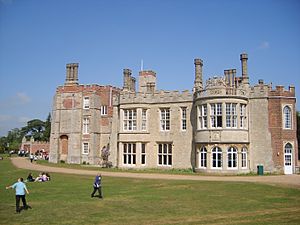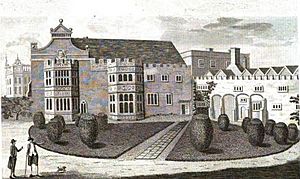Hinchingbrooke House facts for kids
Quick facts for kids Hinchingbrooke House |
|
|---|---|

Hinchingbrooke House (2007).
|
|
| General information | |
| Type | House |
| Country | England |
| Coordinates | 52°19′43″N 0°12′05″W / 52.3286°N 0.2014°W |
| Construction started | 11th century |
| Owner | Hinchingbrooke School |
Hinchingbrooke House is a grand old building located in Huntingdon, Cambridgeshire, England. It's now part of Hinchingbrooke School. This historic house was built around an old nunnery from the 11th century.
After a big change in England called the Reformation, the house became home to the Cromwell family. Later, it belonged to the Earls of Sandwich. One famous owner was John Montagu, 4th Earl of Sandwich, who is said to have invented the modern sandwich! The house was sold in 1962.
Contents
A Look at Hinchingbrooke House History
Hinchingbrooke House has a long and interesting past. It started as a place for nuns and later became a home for important families.
From Nunnery to Family Home
In 1538, a man named Richard Williams (alias Cromwell) received the nunnery of Hinchingbrooke. He was a nephew of Thomas Cromwell, a powerful figure at the time. Richard was helping to close down monasteries and nunneries across England.
A special fireplace found in the house has Richard's initials on it. His son, Henry Williams (alias Cromwell), who was the grandfather of Oliver Cromwell, made even more changes to the house.
What the House Was Like Long Ago
An old writer named Mark Noble visited Hinchingbrooke House often in the 1700s. He wrote that the nuns' rooms were still there and used by servants. The nuns' common room became the kitchen.
The church part of the nunnery was mostly gone, but some small pieces remained in the house walls. He also mentioned that stone coffins were found when the floor was lowered. Henry Cromwell added his family's coat of arms to the windows.
Royal Visitors at Hinchingbrooke
Many important people have visited Hinchingbrooke House over the centuries.
Queen Elizabeth I's Visit
In August 1564, Queen Elizabeth I stayed at Hinchingbrooke. She had just been entertained at Cambridge University.
King James I's Stays
King James I visited Hinchingbrooke on April 27, 1603. Sir Oliver Cromwell, who owned the house then, gave the King gifts like hawks, horses, hounds, and a gold cup. King James returned on December 7, 1610. His son, Prince Henry, also stayed there on August 8, 1612.
Changes and Restorations Over Time
Hinchingbrooke House has been updated and repaired many times throughout its history.
Rebuilding After a Fire
In 1830, a serious fire damaged the house. It was then rebuilt and restored by an architect named Edward Blore. More restoration work happened in 1894.
Discoveries During Modern Repairs
In the 1960s, the house was restored again. During this work, the entrance to the chapter house (a meeting room for the nuns) was found. However, not much of the original medieval building can be seen today. The house was also shown in the Country Life magazine in 1907.
Hinchingbrooke House Today
Today, Hinchingbrooke House is a busy and important part of the community.
Part of Hinchingbrooke School
Since 1970, Hinchingbrooke House has been part of Hinchingbrooke School. It is used for the school's older students (the 6th form). Hinchingbrooke School used to be Huntingdon Grammar School. Famous people like Oliver Cromwell and Samuel Pepys went to that school, which was located where the Cromwell Museum is now. Today, the school has about 1,900 students.
A Place for Events and Fun
Even though it's a school building, Hinchingbrooke House is also used for other things. During the Halloween season, it becomes a popular scare attraction called "The Horror at Hinchingbrooke House." It's also a place for conferences, dinner dances, and weddings.
Hinchingbrooke House is a Grade I listed building, which means it's a very important historical building. You can even take tours of the house on Sunday afternoons during the summer.


